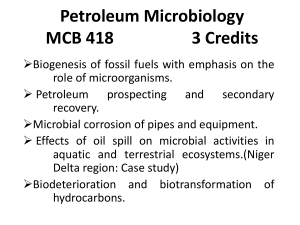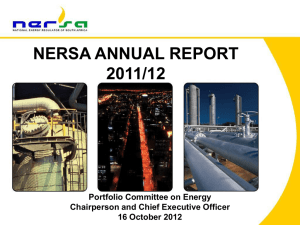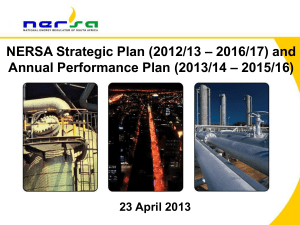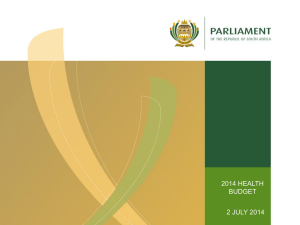South African Energy Sector Policy Research and
advertisement
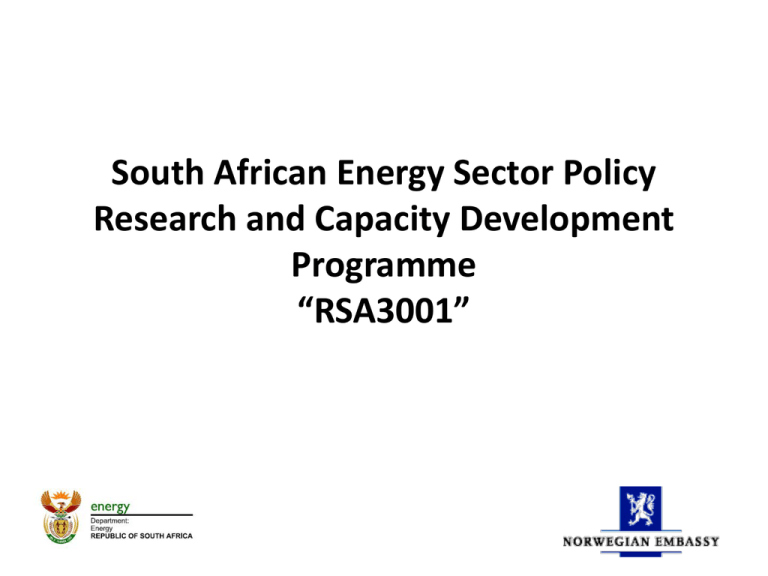
South African Energy Sector Policy Research and Capacity Development Programme “RSA3001” RSA3001 Presentation Outline and Schedule Item no Responsible Duration Opening remarks and welcome: Deputy Director General Hydrocarbons Energy Planning Mr Tseliso Maqubela 15h00-15h10 Presentation by Programme Manager Mr Moeketsi Thobela 15h10-15h20 Sub-programme Presentations CD: Electricity 15h20-15h30 CD: Hydrocarbons 15h30-15h40 NERSA 15h40-15h50 PASA 15h50-16h00 DNA 16h00-16h10 EDC 16h10-16h20 CD: Energy Planning 16h20-16h30 Remarks by NVE Mr Kjell Repp Questions/discussions 2 RSA3001Presentation Outline and Schedule Item no Speech by the Ambassador for Norway in South Africa Speech by Director General-Department of Energy Closing Remarks Snacks and Drinks Responsible H.E Tor Christian Hildan Duration 16h30-16h45 Ms Nelisiwe Magubane 16h45-17h00 Mr Muzi Mkhize 17h00-17h05 17h05/17h30- 3 Purpose of the Presentation • To provide an overview of the RSA3001 Programme • To highlight the key outcomes and achievements of the Programme 4 RSA3001 Programme Overview • Programme Goal : To have legislative and regulatory frameworks in place and implemented, in support of the DOE’s overall energy goals • Programme Purpose: The implementation of concrete interventions towards the establishment of enabling frameworks for effective governance and regulation, equitable market liberalisation and sustainable economic growth • Duration: 2006-2010 5 RSA3001 Programme Structure - Overview • Signatories to the Programme Business Plan: Department of Energy (DoE) and Royal Norwegian Embassy (RNE) • Implementing Agencies: – DoE Chief Directorates: Clean Energy, Electricity, Energy Planning and Hydrocarbons – National Energy Regulator of South Africa (NERSA) – Energy Development Corporation (EDC) – Petroleum Agency South Africa (PASA) • Norwegian Technical Partners: – Norwegian Water Resources and Energy Directorate (NVE) – Norwegian Petroleum Directorate (NPD) • Programme Themes: – Regulation/Energy Planning/Climate Change 6 Assessment framework Efficiency • Extent to which objectives are met Effectiveness • Value of outputs compared to costs Sustainability • Effect on target area/ stakeholders • Will effect outlive the Programme? Impact 7 Measure High-level description Effectiveness A number of policy, legislative and operational deliverables were realised Efficiency Technical support arrangements with NVE and NPD contributed to expedited implementation of selected activities Targeted capacity-building at NERSA, PASA, EDC and Energy Planning was realised Programme Management Committee (PMC) facilitated quick, better informed decision making and improved implementation Impact Some of the outcomes have been used in effective policy, legislative and operational changes Sustainability Systems and outputs created will outlive the Programme Channels to access international expertise/technology created as a result of relationships with Norwegian partner organisations 8 Use of funds (amounts in ZAR) 25,000,000 20,000,000 15,000,000 Income Expenditure Surplus Programme Management (PM) 10,000,000 5,000,000 0 2006/7 2007/8 2008/9 2009/10 9 Use of funds 100.00% 98% 86% 90.00% 80.00% 76% 70.00% 59% 60.00% PM (% of Expenditure) Expenditure (% income) 50.00% 41% Surplus (% income) 40.00% 30.00% 20.00% 24% 14% 13.55% 12.80% 8.93% 10.00% 3.16% 2% 0.00% 2006/7 2007/8 2008/9 2009/10 10 Use of funds Cumulative expenditure - ZAR 45,000,000 40,000,000 42,313,583 35,000,000 28,740,376 30,000,000 25,000,000 20,000,000 18,644,320 15,000,000 10,000,000 7,292,150 5,000,000 0 2006/7 2007/8 2008/9 2009/10 11 If you want to walk fast, walk alone. If you want to go far, walk together. - African proverb - Regulation Theme Department of Energy - CD: Electricity Department of Energy - CD: Hydrocarbons National Energy Regulator of South Africa ( NERSA) Petroleum Agency South Africa (PASA) Electricity Sub-programme (CD: Electricity) Electricity Sub-programme • Goal: – To develop capacity (human and data) to manage and restructure the electricity sector in support of a transparent, competitive and sustainable electricity industry • Purpose: – The implementation of concrete interventions towards capacity-building for effective governance and regulation, equitable market liberalisation and sustainable economic growth and poverty alleviation. • Outputs: – – – – – Promulgated Electricity Pricing Policy (EPP). First used in MYPD2 process. Quality of Supply Report Load-flow model for WC2010 and report Draft IPP Framework Report Training (e.g. regulatory training as part of ELRI) 15 Measure Key examples Effectiveness Electricity Pricing Policy (EPP): Used in re-valuing generation assets as part of the MYPD 2 process. Load-flow model: Provided indication of reticulation network constraints around key supply areas of WC2010 host cities and Ekurhuleni. Draft IPP Framework: Provided input towards the development of legislation to establish an independent system and market operator (ISMO). Efficiency EPP: Developed by local consultants, thereby reducing cost. Load-flow model: Co-operation agreement between CD: Electricity and NVE facilitated an expedited development of the model. 16 Measure Key examples Impact EPP: Improved regulatory certainty could potentially support new generation investments and energy efficiency. Load-flow model: Highlighted importance of 11kV system in electricity supply chain. Draft IPP Framework: ISMO expected to facilitate IPPs Sustainability EPP: Will serve as reference for price adjustments in future. Draft IPP Framework: Development of ISMO legislation will institutionalise key aspects of the framework. 17 Hydrocarbons Sub-programme (CD: Hydrocarbons) Hydrocarbons Sub-programme • Goal: – To develop capacity (human and data) to manage and restructure the hydrocarbons sector in support of a transparent, competitive and sustainable hydrocarbons industry • Purpose: – The implementation of concrete interventions towards capacity-building for effective governance and regulation, equitable market liberalisation and sustainable economic growth and poverty alleviation. • Outputs: – – – – – Strategic Stocks Study Petroleum Licensing System Regulatory Accounts and Report Draft Regulatory Accounting Models for petroleum pricing Training (e.g. financial analysis as part of petroleum licensing process; MEETI industry-specific training) 19 Measure Key examples Effectiveness Strategic Stocks Study: Provided options for consideration in developing Strategic Stocks Policy. Petroleum Licensing System: Put in place regulations and an enabling IT system in support of the Petroleum Products Act (PPA). Regulatory Accounts: Provided a basis for increased transparency in pricing, as well as regulatory reform in support of the PPA – addressing regulatory asymmetry. Efficiency Strategic Stocks Study: Use of local consultants reduced cost. Petroleum Licensing System: Increased operational efficiencies. 20 Measure Key examples Impact Strategic Stocks Study: Potential contribution to energy security by providing basis for policy on crude oil and product stocks. Petroleum Licensing System and Regulatory Accounts: Contribution towards managed liberalisation in support of the Energy White Paper (1998) and the implementation of the PPA. Sustainability Strategic Stocks Study: Institutionalisation by way of revised Policy underway Petroleum Licensing System: Alignment with regulations means system has been institutionalised. 21 Energy Regulation Subprogramme (NERSA) Energy Regulation Sub-programme • Goal: – To research and capacitate the framework and mechanisms for regulation of the energy sector • Purpose: – The implementation of concrete interventions towards the development of the policy framework and capacity for sustainable regulation of the electricity sector. • Outputs: – Licensing Information System (LIS) operational at targeted municipalities – Electricity Regulators Initiative (ELRI) Workshop – Staff Training Workshop 23 Measure Key examples Effectiveness Licensing Information System (LIS): Use of a web-based platform would contribute to improved data collection. NVE-NERSA workshops (including ELRI): Provided a platform to share regulatory expertise as part of capacity-building. Efficiency LIS: The use of NERSA staff members in rolling-out the system resulted in lower costs. NVE-NERSA workshop: Holding the NVE-NERSA workshop in SA resulted in lower costs (e.g. participation by more NERSA staff members). 24 Measure Key examples Impact LIS: Will simplify the information supply process. NVE-NERSA workshop: Has contributed to the institutional capacity required by NERSA in regulating an increasingly complex electricity industry. Sustainability LIS: Continued use will be supported by the fact that information supply is a legal requirement, as well as its ease-of-use. NVE-NERSA workshop: Participation by large number of NERSA staff members will mitigate effect of staff attrition. 25 Upstream Petroleum Subprogramme (PASA) Upstream Petroleum Sub-programme • Goal: – Transformation of the core functions of the Agency under the MPRDA, improve capacity to evaluate resources. • Purpose: – To facilitate a smooth transformation of the core functions of the Agency under the MPRDA, and facilitate the completion of South Africa’s Extended Continental Shelf Claim. • Outputs: – Institutional Capacity Review/Training Needs Analysis – Development and implementation of training programme – Shelf-claim filed 27 Measure Key examples Effectiveness Institutional Capacity Review (ICR): Highlighted PASA’s organisational weaknesses (e.g. high proportion of staff members due for retirement). Training Needs Analysis (TNA): Provided basis for the development and implementation of a training framework. Continental shelf claim: SA’s continental shelf claim was filed with the UN. The outcome will be known in due course. Efficiency ICR and TNA: Combining these initiatives resulted in a targeted training programme. Continental shelf claim: The co-operation agreement with NPD facilitated access to the expertise required to file SA’s claim. 28 Measure Key examples Impact ICR and TNA: Improved PASA’s ability to quantify petroleum resources, apply internationally accepted reporting standards and regulate the upstream sector, including unconventional on-shore gas resources. Continental shelf claim: A successful claim will double SA’s maritime territory and potentially increase the resource-base. Sustainability ICR and TNA: The participation of staff members from across a wider range of skill and experience profiles – including interns - contributed to the sustainability of capacity-building efforts. 29 Climate Change Theme Designated National Authority ( DNA) Energy Development Corporation (EDC) Alternative Energy Subprogramme (DNA) Alternative Energy Sub-programme - DNA • Goal: – Promote and regulate low carbon energy options in a manner that encourages local economic growth and poverty alleviation • Purpose: – The implementation of concrete interventions towards the of the development of alternative low carbon energy options. • Outputs: – First Annual CDM Tracking Report – CDM database 32 Measure Key examples Effectiveness The consolidated CDM project database and report provided the DNA with a first quantitative review of the CDM market in South Africa Efficiency The use of local consultants contributed to lower costs. The project was delivered within the specified budget and one month after the target date. Impact ICR and TNA: The capacity built through the database provides a central repository for the DoE to monitor CDM development using internal human resources. The DNA will be able to evaluate and promote CDM projects as there is now better understanding of market gaps and challenges. Sustainability The outputs can be shared with other government departments and agencies involved in emissions reduction and CDM. The DoE plans to compile a status report annually. 33 Alternative Energy Subprogramme (EDC) Alternative Energy Sub-programme - EDC • Goal: – Capacity and policy developed to promote and operationalise low carbon energy options in a manner that encourages local economic growth and poverty alleviation • Purpose: – The implementation of concrete interventions towards the development of the policy framework and capacity for development of alternative low carbon energy options. • Outputs: – Institutional Capacity building – Biofuels Roll-out – CDM capacity building – Wind, Solar, Hydro development 35 Measure Key examples Effectiveness Institutional capacity-building: Enhanced EDC’s understanding of RE technology trends and economics (e.g. biofuels, hydro and wind). CDM capacity-building: Appointment of a specialist facilitated the compilation of CDM documentation (e.g. PIN and PDD). The SSH Guidelines implementation workshop facilitated by EDC has enhanced capacity to implement policy in support of SSH. Efficiency The use of local consultants for the biofuels/hydro feasibility studies and the hybrid study lowered costs. Workshops on small scale hydro and wind held in Cape Town and Port Elizabeth allowed for participation from SA and neighbouring countries. The workshops were facilitated by NVE in terms of technical support agreement 36 Measure Key examples Impact SSH: Improved regulatory certainty as a result of the development and implementation of SSH guidelines. Capacity building: skills transferred have increased RE development capacity within EDC Sustainability Capacity built in CDM, hydro and biofuels development will enable EDC and its stakeholders to implement low carbon options in future 37 Energy Planning Theme (CD: Energy Planning) Energy Planning – DoE • Goal: – Secure and sustainable consumption, production and transportation of diversified energy resources, taking into account interactions with the macro-economy and natural environment. • Purpose: – Develop capacity to enable informed planning, decision-making as a way of securing sustainable consumption, production and transportation of diversified energy resources, taking into account interactions with the macro-economy and natural environment. • Outputs: – Energy Security Master Plan (ESMP) Project Plans – Energy Modelling System User Requirements Specifications – Capacity building in Energy modelling and planning as well as Energy Data Management (e.g. in support of the National Energy Act (2008) 39 Measure Key examples Effectiveness Energy Security Master Plan (ESMP): Specified requirements for infrastructure investments. National Integrated Energy Modelling System (NIEMS): Resulted in user requirement specifications which were discussed extensively with various stakeholders (intra- and inter-departmental as well as SOEs). NIEMS: Resulted in a governance framework in support of data collection for the purposes of energy modelling.The framework also provided a basis for the development of regulations in support of the National Energy Act (2008). Efficiency ESMP: Development of project plans via bilateral meetings with industry participants although time-consuming yielded better quality information. NIEMS: Adaptation of an existing framework is aimed at contributing towards reduced development requirements – although will take longer than implementing an off-the-shelf tool. Bottom-up development will enable for a system to be customised for South African context 40 Measure Key examples Impact ESMP: Timely warning of the requirement to coordinate WC2010 planning. NIEMS: Highlighted importance of separating modelling and planning. Sustainability ESMP and NIEMS: Experience gained will contribute to the development of structures, processes and systems to promote energy security, as envisaged in the National Energy Act (2008). 41 Remarks by NVE 42 Questions/Discussion 43



